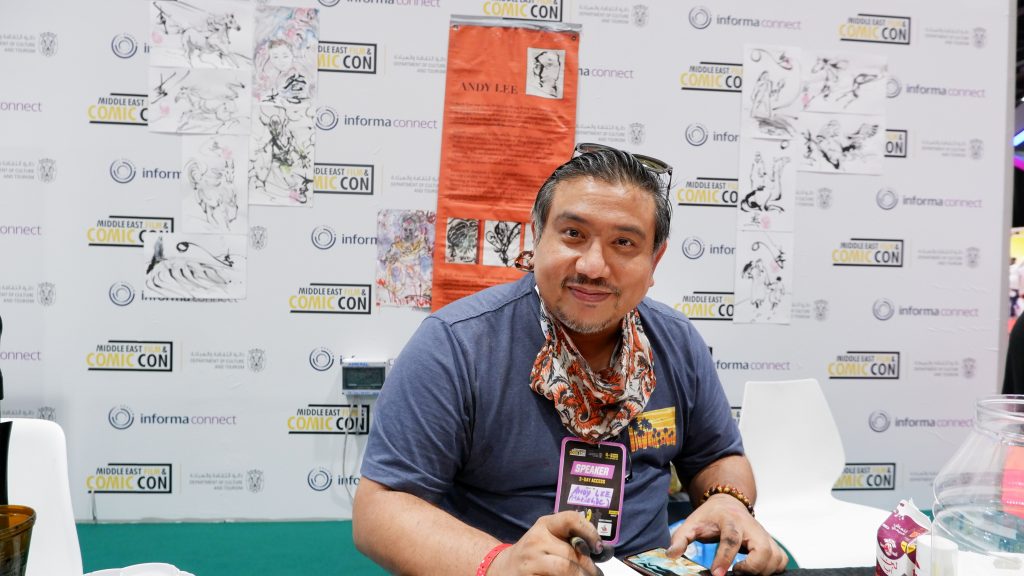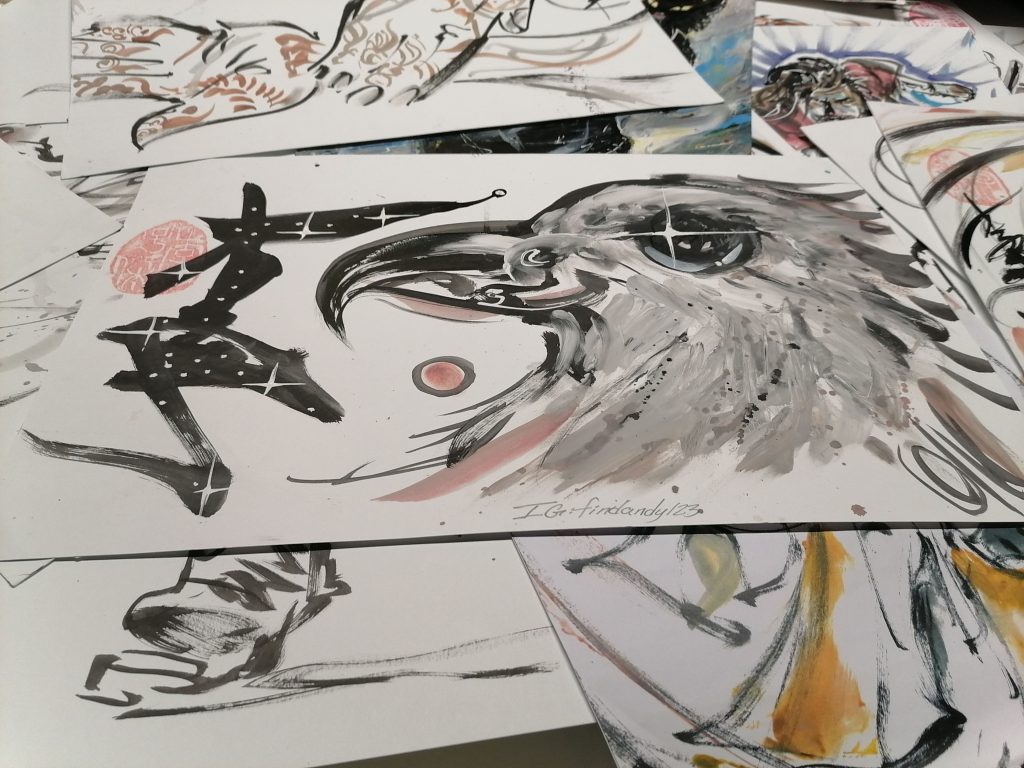



ABU DHABI: Andy Lee, an artist from Hong Kong, travelled to and from between East and USA, resulting in a unique art aesthetic combining Zen brush with pop culture.
Some of his credits include illustrations in Dragonball Z, Inuyasha Magazine, DC Comics Versus Trading Cards (Bronze Tiger, Sensei), Kindred of the East’s Vampire the Masquerade, Ultimate Marvel Team-Ups (Spider Man vs the Master of Kung Fu), and much more.
Exclusively to Arab News Japan, Lee shared his love for pop culture, saying: “When I was young, I went to the library every day and enjoyed the plethora of comics that was afforded to me for free, specifically the Watchmen graphic novel, Dark Knight Returns by Frank Miller, Elfquest and many more.”
“Frank Miller was the first comic book artist and writer I became a fan of, so after his Dark Knight Returns (Batman narrative) I became a fan of his Wolverine due to his ability to bring a character to life; his Spider-Man vs Wolverine set in Germany was the final stepping stone towards my visual romance with drawing Spidey a lot in my early teen years; which happened to be when I was introduced to the black Sumi ink and bamboo brush method of painting; the lessons I retained (on brush handling and mark making) to paint bamboo and plum blossoms were secretly used at home to paint Spider-Man, something I was too embarrassed to show my traditionalist teachers the next day.”
“Zen painting uses one’s modern surroundings (both visually and culturally) to finish splashes into recognizable modern landscapes or objects or even fantasies that are commonly held in the times. Therefore, it only benefits me to not let go of the past and use it as a language to empathize and relate to others, to use popular knowledge in metaphors and jokes, especially in this day and age where every 10 to 20 years remakes (and therefore, m. CD a guarantee in modern popular cinema and product sales. Therefore, to remember what brought me joy in my past is a great visual resource for contextual art communication,” he added.
About the establishment of his career as an illustrator, Lee said: “My ability to illustrate well was always intensified through appreciation of anyone who likes to watch how I paint, and I loved to oblige. Both in the process of quickly revealing the image desired after I make a Seemingly random splash as well as demonstrate my complete abandon of using anything from fingers to elbows to brushes to finish the piece off. My illustration method is very kinetic and it would have been that way whether I had an audience or not because that is a Zen principle anyway (of having no rules) when finishing off an image.”
About his early projects in the illustration field, Lee said: “Several small ones like designing buttons and digital consoles for a computer audio editor programmed by my Uncle Sam Lee.”
“However, the first very popular thing that I worked on for the illustration field was the cover, inside cover and spot illustrations throughout the White Wolf Kindred of the East Vampire the Masquerade series gaming books.”
“The concept was a very liberating one as directed by the editor at the time Lawrence Snelly. He allowed me to create art using the technique that I was taught which is Zen painting techniques with several brushstrokes that insinuates a subject yet purposely looks incomplete, which is intentional monks believed because your mind interacts with the image and creates a complete picture. This Asian technique was borrowed into pop-culture by using it to paint vampires that are skeletons, tiger humans, dragons, Chinese characters, and other topics. was a perfect fit for my style and method. It opened my eyes to the limitless possibilities this traditional style could offer when using it to look at popular culture or modern themes,” he added.
Andy Lee is known for his work on illustrations in Japanese manga magazines, he told Arab News Japan the story of his work on those magazines: “The process was always very smooth due to the very considerate and etiquette following attitudes of the editors and publishers that hired me to do the jobs. Inuyasha was hard because I needed to make a Map and Dragonball Z was such a delight I was allowed to splash paint; one was 3 pages and took weeks and the other was a cover that took a minute to paint. It really makes me consider the time taken vs. cost paradigm especially since I believe coloring in layers is eventually going to get beautiful even after hours but the one stroke method you only have one chance that get it right so …which requires more skill? Therefore, the most memorable part of any job that I take on is to gently figure out what version of myself the client really wants, because that takes the most tact.”
About his visit to the Middle East, Lee said: “My first time was last March for the Middle East Film and Comic Con in Abu Dhabi and taught a few art workshops. I had such a wonderful experience and met many friends for life. I always feel honored to share the techniques of Zen art with new people and different cultures. People were so kind. I have been fortunate to connect with such amazing people 14,000 km from my home.”
About his visit to Japan, Lee said: “Nagoya’s Aichiken for the DBZ origins of aesthetics as the creator was raised there. Shibuya for its lack of limits if LED’s OC’s and one’s daydreams ruled the world and Tokyo for obvious reasons. I’d still like to follow in the footsteps of one of my favorite directors of all time (directed Ran, Rashamon, etc…), Akira Kurosawa’s haunts and filming locations. I also wished I toured a katana foundry but hadn’t the right connections.”
“I was fortunate enough to briefly work at a factory in Aichiken, that made plastic parts for Toyota, the Hybrid. The clear blue plastic gear knob /shifter part that reads what gear the driver is on via factory painted white fonts. The quiet but unshakable work ethic of the Nation really presented itself in that experience. Their ability to maintain drive no matter how laborious or trivial the action. Everyone is hyper focused and very intensely concerned for quality and perfection in every blue transparent plastic gear shifter nob /gearshift indicator. After a month I was given a small gift a handmade top to spin, it was such a profound metaphor. I cried from appreciation for their sharing of the experience waking up early exercising in a circle and giving their all, all day,
As far as the plastic molds coming out of the automated mold press there would be only one or two imperfections in a thousand pieces. Our job was to find and eliminate and box the perfect ones. Nothing in typical tourist areas taught me more about the fighting spirit of Japanese more than working and drinking w the blue Collar of Nagoya,” he added.